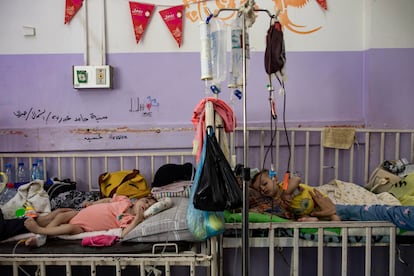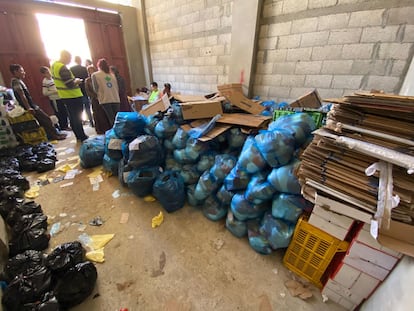‘Palestinians are on the brink of famine’
The NGO Action Against Hunger warns that 30% of children under two years of age in the Strip are suffering from acute malnutrition

Palestinians face famine “in the coming months.” That is the disturbing projection of aid worker and nutrition specialist Cristina Izquierdo, a member of the NGO Action Against Hunger. Izquierdo has just returned to Spain after a month of humanitarian work in Gaza and has outlined the bleak panorama she has witnessed in recent weeks. “The level of destruction of vital infrastructure, such as hospitals, schools, or sanitation facilities, has left Palestinians without access to any basic services. If aid does not arrive, Gaza will collapse,” she told EL PAÍS Tuesday at the NGO’s headquarters in Madrid.
The precarious food situation can be seen in the faces of Gaza’s residents, according to the volunteer from Barcelona. “The Palestinians are starving and their bodies are not receiving the necessary energy; the tissues are decomposing and the skin is affected. That’s why we see images of people looking emaciated,” she said. Conditions for children are even worse: “Lack of food slows growth and development. In many situations it is irreversible and the immune system fails, so many die of infection.” The population of the Strip, she emphasized, “is on the verge of famine,” the most serious phase of food insecurity, with an elevated risk of death by starvation, according to the global reference classification.
The United Nations had already warned in mid-March that famine in northern Gaza was “imminent” due to the blockade by Israeli troops on humanitarian aid entering the Palestinian enclave. For famine to be declared in a population, three criteria must be met: 20% of the inhabitants must be suffering from hunger; child malnutrition must be over 30%; and two out of every 10,000 deaths per day must be due to lack of food. But Izquierdo notes that “there must be an international consensus” to verify that these circumstances exist.
Although the aid worker said that the process to determine whether famine should be declared is “complex,” her NGO is already aware that 30% of children under two years of age in the Strip are suffering from acute malnutrition. At the end of May, 50 other humanitarian organizations called on the United Nations and “international institutions” to declare famine. “With border crossings closed and humanitarian aid blocked by Israel, acute malnutrition has resurfaced and spread rapidly,” they warned in a statement.

“There are no roads to bring in aid”
Fenia Diamanti, head of the NGO’s field team base in Gaza, has also just returned from the Strip. According to her, the situation in Rafah, where the Israeli army is now concentrating its ground offensive, is critical. “In the last few weeks, and after several evacuations, we can only distribute drinking water, shelter kits, and what little fresh food is left,” she says. For Diamanti, the problem of food access for the population is not only due to the blockade, but also because of the difficulties of unloading and transportation within the Strip. “There are no storage sites and there are no roads to bring in aid; it is almost impossible to reach the north [of Gaza].”
Humanitarian work, like any other activity in Rafah, has been affected by the Israeli military siege. “We had to leave our office again and many left their homes. We also had warehouses with food or hygiene materials and we no longer know what state they are in,” says Diamanti.
Food airdrops, as well as the arrival of aid through a seaport built by the U.S. — which is no longer operational — are insufficient measures, according to Diamanti. “A single entry will not do. We need border ports and land routes to be opened.” According to the UN, only 216 trucks of humanitarian aid entered the Strip through the Kerem Shalom crossing last month. That is an average of eight per day. The Rafah crossing has been closed since Israel took control of the border corridor between the Strip and Egypt last week.
Action Against Hunger has insisted that even though a famine has not been declared in Gaza, people are already dying from hunger-related diseases or infections. According to the Hamas-controlled Ministry of Health in the Strip, at least 30 people, mostly children, have died from acute malnutrition.
Sign up for our weekly newsletter to get more English-language news coverage from EL PAÍS USA Edition
Tu suscripción se está usando en otro dispositivo
¿Quieres añadir otro usuario a tu suscripción?
Si continúas leyendo en este dispositivo, no se podrá leer en el otro.
FlechaTu suscripción se está usando en otro dispositivo y solo puedes acceder a EL PAÍS desde un dispositivo a la vez.
Si quieres compartir tu cuenta, cambia tu suscripción a la modalidad Premium, así podrás añadir otro usuario. Cada uno accederá con su propia cuenta de email, lo que os permitirá personalizar vuestra experiencia en EL PAÍS.
¿Tienes una suscripción de empresa? Accede aquí para contratar más cuentas.
En el caso de no saber quién está usando tu cuenta, te recomendamos cambiar tu contraseña aquí.
Si decides continuar compartiendo tu cuenta, este mensaje se mostrará en tu dispositivo y en el de la otra persona que está usando tu cuenta de forma indefinida, afectando a tu experiencia de lectura. Puedes consultar aquí los términos y condiciones de la suscripción digital.
More information
Archived In
Últimas noticias
What is known about the Interoceanic Train derailment in Oaxaca
Trump turns a Minnesota fraud allegation into ammunition for his MAGA army against Democrats
The year Trump created 1.6 million undocumented immigrants
Russia threatens to break off negotiations after accusing Ukraine of attacking one of Putin’s residences
Most viewed
- Reinhard Genzel, Nobel laureate in physics: ‘One-minute videos will never give you the truth’
- Oona Chaplin: ‘I told James Cameron that I was living in a treehouse and starting a permaculture project with a friend’
- Pablo Escobar’s hippos: A serious environmental problem, 40 years on
- Chevy Chase, the beloved comedian who was a monster off camera: ‘Not everyone hated him, just the people who’ve worked with him’
- Why we lost the habit of sleeping in two segments and how that changed our sense of time










































